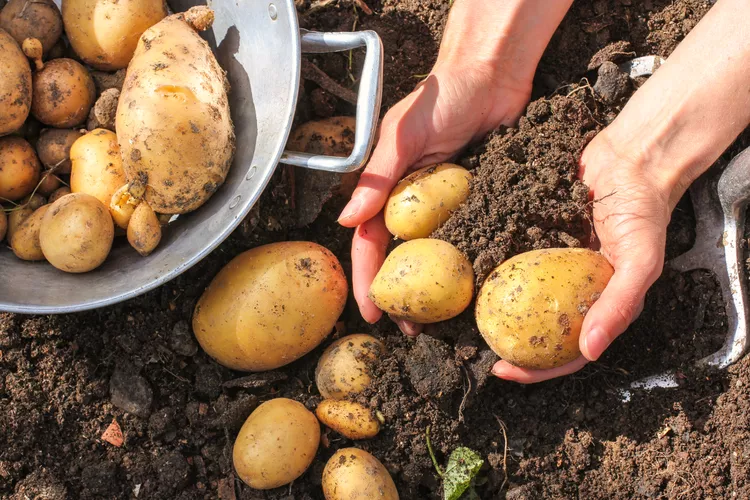Potatoes are easy to grow in your garden where you can experiment with different varieties. When to harvest potatoes depends on your region and the type you're growing. Spuds are a warm-season crop in the North, because frost and light freezes will kill the tops, and a cool-season crop in the South and West. Here’s what you need to know about how and when to harvest potatoes to get the most out of this versatile vegetable.
Types of Potatoes
Each type of potato has been bred and selected for specific qualities such as the color of the skin and flesh or whether it is good for baking, boiling, or used for salad. There are also three main categories of potatoes based on harvest time: first early variety, second early variety, and main crop.
First early varieties are planted between the end of February and early May. They typically are ready to be harvested 10 weeks after planting. These varieties are ideal options when planting in potato grow bags or large containers. A few to look for include ‘Arran Pilot’, ‘Foremost’, and ‘Pentland Javelin’ among many others.
Second early varieties are typically harvested 12-16 weeks after planting. They include ‘Estima’, ‘Marfona’, and ‘Wilja’.
Main crop varieties include ‘Cara’, ‘King Edward’, ‘Pink Fir Apple’, ‘Romano’, and many others. These varieties are left the longest in the ground, usually until fall. Then they are typically all harvested at once for storage.
When to Harvest Potatoes
Once the haulm (stems & leaves) start to flower on early varieties, that's a sure sign that the plant has potatoes ready to harvest.
If you want to harvest a few tender “new” potatoes from around the edge of each plant when the vines start to flower (about 8 weeks after planting), use your hand to carefully remove a few potatoes from the ground without uprooting the entire plant.
“New” potatoes taste deliciously sweet straight from the garden because their sugars haven't yet converted to starch as it will in mature spuds.
Harvesting Techniques
Each category of potato is harvested differently.
- For earlies, dig a garden fork in well below the potatoes and lever them out of the soil, while at the same time pulling up on the haulm.
- For main crop varieties, remove the stems and leaves about two weeks before harvesting so that the skins on the potatoes thicken up. Lift the main crop with a garden fork on a dry, warm dry and leave them lying in the sun for a day or two to let the skins dry.
How to Cure and Store Fresh Potatoes
If you leave potatoes in light for too long, this will encourage the tuber to turn green and sprout. Pack clean, dry potatoes in burlap or paper sacks and store them in a dark, cool, but frost-free place. Alternatively, they can be stored on trays as long as no lights get to the tubers.
If any potatoes were pierced with the garden fork while harvesting, you can "cure" them, which toughens up the potato’s skin and extends its storage life. To do so, leave freshly harvested potatoes for two weeks in a dark place with high humidity and a temperature of 50 to 60°F, loosely covering the tubers with burlap. Spring and summer harvested potatoes aren’t usually stored, but you can keep them for 4 to 5 months if cured first at 60 to 70°F for at least 4 days and then stored at a temperature of 40°F.
After drying fall-harvested potatoes for 1 to 2 days on the ground, cure them at 50 to 60°F and high humidity for 10 to 14 days. Once cured, store your spuds in a cool, dry spot in total darkness in a single layer. Never layer or pile potatoes more than 6 to 8 inches deep or they may rot more easily.




















